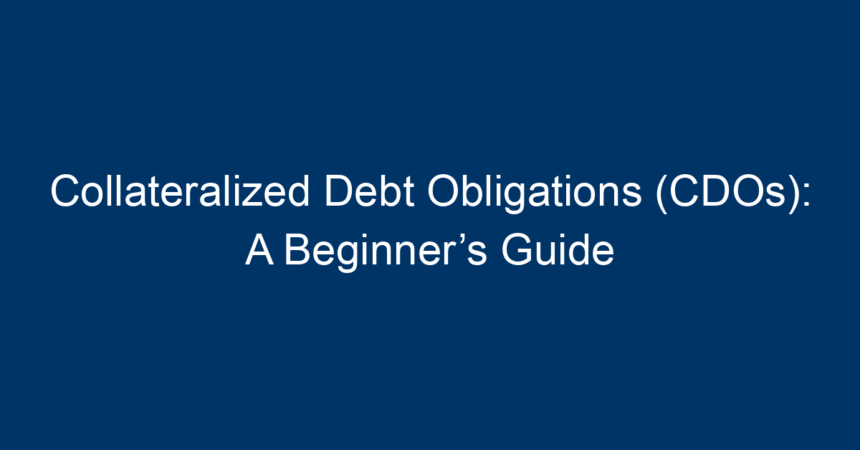In the complex world of finance, collateralized debt obligations (CDOs) play a crucial role in investment strategy and risk management. For those unfamiliar with financial instruments, the term may sound intimidating. However, understanding CDOs can provide valuable insights into how credit markets function and how investors can harness these tools for better returns. In this comprehensive guide, we will explore what CDOs are, how they work, their types, risks and benefits, and actionable insights for beginners.
What Are Collateralized Debt Obligations (CDOs)?
Collateralized debt obligations (CDOs) are structured finance products that pool together various types of debt—such as loans, bonds, and mortgages—and sell them to investors as securities. They are designed to manage risk and provide different return profiles based on the underlying assets’ performance.
The Mechanics of CDOs
-
Asset Pooling: A financial institution gathers loans or other types of debt into a single pool. This could include residential mortgages, commercial loans, or corporate bonds.
-
Tranching: The pooled debt is divided into different tranches, which are layers of risk and return. These tranches—ranging from senior (lowest risk) to junior (highest risk)—influence how income from the underlying assets is distributed.
- Securitization: Investors purchase these tranches as securities, receiving regular payments derived from the cash flows of the underlying assets.
Types of CDOs
Understanding the types of collateralized debt obligations (CDOs) can help investors choose the right instruments according to their risk appetite.
1. Cash Flow CDOs
These CDOs are primarily reliant on the cash flows generated from the underlying debt assets. Investors receive payments as these debts are paid off.
2. Market Value CDOs
Also known as CDOs of ABS (Asset-Backed Securities), these focus on the market value of the underlying assets. They are susceptible to market fluctuations, making them riskier but potentially offering higher returns.
3. Synthetic CDOs
Synthetic CDOs do not hold physical assets; instead, they invest in credit default swaps (CDS) to gain exposure to credit risk. This structure allows investors to speculate on the creditworthiness of various entities without the need for direct asset ownership.
The Benefits of CDOs
Collateralized debt obligations (CDOs) offer several advantages, making them attractive to many investors.
1. Diversification
By pooling a variety of debt instruments, CDOs offer investors a diversified exposure to different credit risks, which can mitigate individual asset risk.
2. Customized Risk Management
CDOs provide varied tranches to suit different risk appetites. Conservative investors can choose senior tranches for lower risk, while risk-tolerant investors can opt for junior tranches that may yield higher returns.
3. Enhanced Yield
CDOs can offer higher yields compared to traditional bonds and fixed-income instruments. This is due to the complexity and risks associated with the underlying assets.
Risks Involved with CDOs
While collateralized debt obligations (CDOs) present opportunities, they also come with significant risks.
1. Credit Risk
If the underlying debtors default on their payments, this can severely impact the cash flow to investors, particularly those in lower tranches.
2. Market Risk
The performance of CDOs can be affected by broader market conditions. Declines in asset values may lead to reduced investment performance.
3. Complex Structure and Lack of Transparency
The intricacies involved in CDOs can lead to confusion. Investors may find it challenging to assess the true level of risk involved, particularly in synthetic CDOs.
How Are CDOs Rated?
Credit rating agencies play a critical role in assigning risk ratings to different CDO tranches. The ratings help investors make informed decisions by assessing the likelihood of default on the underlying debt.
Understanding Ratings
- Investment-Grade Ratings (AAA, AA): Indicate lower risk; generally, senior tranches fall into this category.
- Non-Investment-Grade Ratings (BB, B, CCC): Reflect higher risk; typical for junior tranches which may offer higher potential returns.
Analyzing Current Market Trends
As of our latest insights, the market for collateralized debt obligations (CDOs) is witnessing a resurgence post-2008 financial crisis. Investors are showing renewed interest, partly due to low-interest rates making yield generation important.
Emerging Opportunities
Investment in CDOs is increasingly focused on sustainable assets, such as green bonds, as investors look to diversify and align portfolios with environmental goals.
Actionable Insights for Beginners
For those new to collateralized debt obligations (CDOs), consider these actionable steps:
1. Educate Yourself
Before diving into CDO investments, take the time to familiarize yourself with all aspects of structured finance. Read articles, research papers, and market reports.
2. Consult Financial Advisors
Engage with financial advisors who understand CDO structures and can guide you based on your financial goals and risk tolerance.
3. Start Small
If you decide to invest in CDOs, start with a smaller amount to evaluate their performance without exposing your entire portfolio to risk.
4. Stay Informed
Regularly update yourself on market trends, interest rates, and economic indicators, as these can affect the performance of CDOs.
5. Assess Performance Regularly
Monitor the performance of your CDO investments and make adjustments as necessary based on market conditions and your investment goals.
Conclusion
Collateralized debt obligations (CDOs) offer a unique blend of opportunity and risk that can be beneficial for savvy investors. Understanding their structure, types, risks, and market trends enables effective investment strategies. As a beginner, the key to successfully investing in this complex financial instrument lies in thorough research, engagement with financial experts, and prudent risk management. By following these guidelines, you can navigate the world of CDOs with confidence and embark on a rewarding investment journey.




